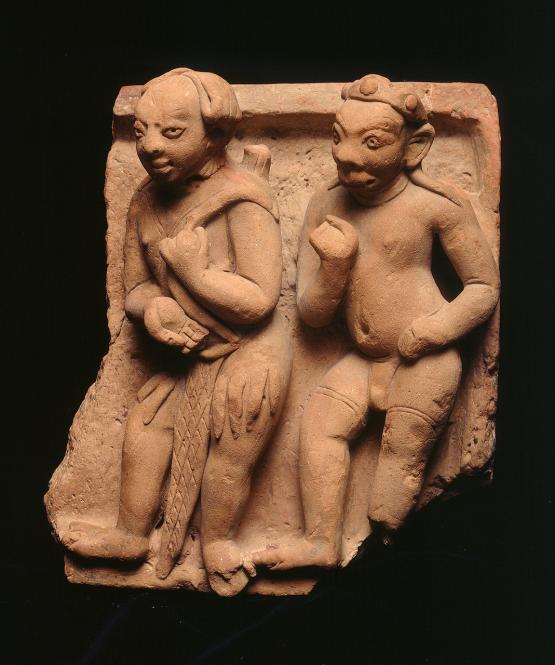
Object Title
Rama and Sugriva set out to find Valin?
Measurements
32 x 27.7 x 12.5 cm (12 9 /16 x 10 7/8 x 4 15/16 in.)
Creation Date
c. 5th Century CE
Credit Line
James W. and Marilynn Alsdorf Collection. Gift of Marilynn Alsdorf
Museum Name
Museum Contact
publicaffairs@artic.edu
Culture
Country of Origin
Object Type
Materials / Techniques
Object URL
https://www.artic.edu/artworks/130961/rama-and-sugriva-set-out-to-find-valin
Museum's Definition of Antiquity
Created before late 6th Century CE
Provenance Information
With Kapoor Galleries, New York, by 1983 [this and the following according to invoice from Kapoor Galleries, July 27, 1983; copy in curatorial object file]; sold to James W. Alsdorf (1913–1990) and Marilynn B. Alsdorf (1925–2019), Winnetka and Chicago, IL, 1983; by descent to Marilynn B. Alsdorf, Chicago, 1990 [on long-term loan at the Art Institute of Chicago, Sept. 23, 1983; publicly promised as a gift to the Art Institute of Chicago, 1997; signed a promised gift agreement for the work, Apr. 23, 2008]; given to the Art Institute of Chicago, 2021.
Exhibition Information
Brooklyn Museum of Art, From Indian Earth: 4,000 Years of Terracotta Art, Jan. 17–Apr. 14, 1986, cat. 95.
Publication Information
Amy G. Poster, From Indian Earth: 4,000 Years of Terracotta Art. (New York: The Brooklyn Museum, 1986), 57, cat. 95.
Pratapaditya Pal with contributions by Stephen Little, A Collecting Odyssey: Indian, Himalayan, and Southeast Asian Art from the James and Marilynn Alsdorf Collection (Chicago: The Art Institute of Chicago in association with Thames and Hudson, 1997), 41 (ill.), cat. 40, 280–1.
Laxshmi Greaves, “Locating the Lost Gupta Period Ramayana Reliefs from Katingara, Uttar Pradesh” Religions of South Asia, 12, no 2, Equinox Online, 2018: 117–153.
Pratapaditya Pal with contributions by Stephen Little, A Collecting Odyssey: Indian, Himalayan, and Southeast Asian Art from the James and Marilynn Alsdorf Collection (Chicago: The Art Institute of Chicago in association with Thames and Hudson, 1997), 41 (ill.), cat. 40, 280–1.
Laxshmi Greaves, “Locating the Lost Gupta Period Ramayana Reliefs from Katingara, Uttar Pradesh” Religions of South Asia, 12, no 2, Equinox Online, 2018: 117–153.
Section of the AAMD Guidelines relied upon for the exception to 1970
Cumulative facts and circumstances
Explain why the object fits the exception set forth above
This acquisition falls within two exceptions: cumulative facts and circumstances as well as gift or bequest expected or on loan prior to 2008. First, the cumulative facts and circumstances known to the Art Institute of Chicago at the time of the acquisition allowed it to make an informed judgment to acquire the object. The object was purchased by James Alsdorf and Marilynn Alsdorf, Winnetka and Chicago, Illinois, from Kapoor Galleries, New York in 1983, according to the invoice, a copy of which is in the curatorial object file. Attempts to determine from whom the gallery acquired the object were unsuccessful. The object was included in an exhibition at the Brooklyn Museum of Art in 1986 and has also been displayed publicly at the Art Institute of Chicago, in the Indian, Himalayan, and Southeast Asian Art Galleries in McKinlock Court from 2000 to 2005, and again in the Alsdorf Galleries of Indian, Southeast Asian, Himalayan and Islamic Art between 2008 to 2018. The object has been published in two major catalogs and in one article on South Asian Art: From Indian Earth: 4,000 Years of Terracotta Art (1986); A Collecting Odyssey: Indian, Himalayan, and Southeast Asian Art from the James and Marilynn Alsdorf Collection (1997); and “Locating the Lost Gupta Period Ramayana Reliefs from Katingara, Uttar Pradesh” (2018). In addition, the object will be the only example in the Art Institute’s collection of a terracotta frieze from the Ramayana epic depicting a narrative from the classical Gupta period (5th/6th Century CE) of Indian art. Second, the acquisition of the object was by gift and the object was on loan to the Art Institute prior to 2008. The Alsdorfs lent the object to the Art Institute of Chicago on Sept. 23, 1983; Marilynn Alsdorf publicly promised the object as a gift to the museum in 1997; and the object joined a larger group of promised gifts in an agreement signed on Apr. 23, 2008.